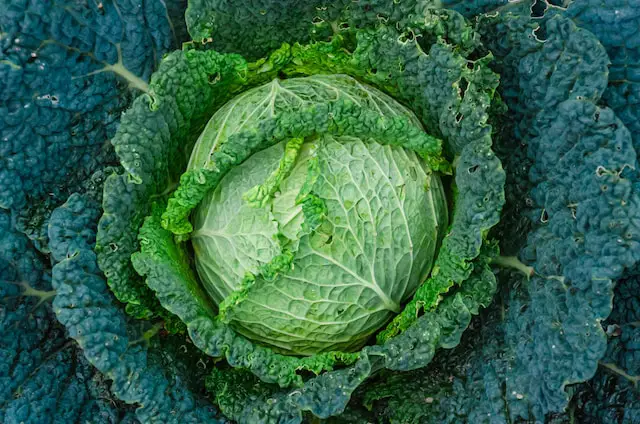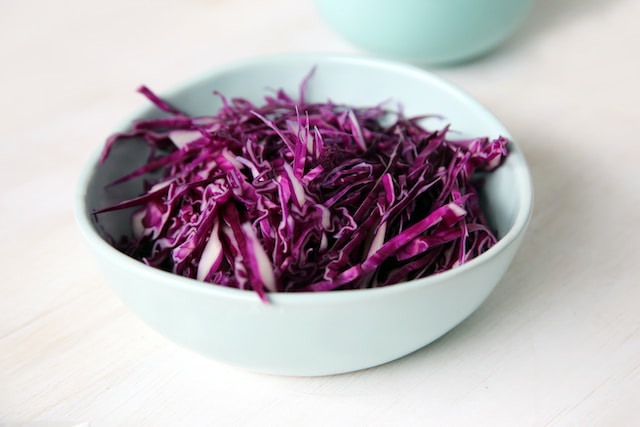While green cabbage is more commonly used for cooking due to its mild flavor, purple cabbage is known for its vibrant color and higher nutritional value. Both types of cabbages offer various health benefits and can be enjoyed cooked or raw.
Green Cabbage

Green cabbage, also known as white cabbage, is the most common type of cabbage available on the market. It has a round shape and tight head with pale green leaves that are smooth and slightly rubbery to touch.
The flavor of green cabbage is mild and sweet, making it perfect for salads or raw dishes. When cooked, it becomes tender but still retains its crunchiness. It’s well-suited for recipes such as coleslaw, sautéed vegetables or stir-fries.
Green cabbage is also packed with nutrients such as vitamin C, vitamin K and fiber which make it an excellent vegetable to add to your diet. Plus, it’s low in calories which makes it an ideal food for weight loss diets.
When buying green cabbage at the store or farmer’s market look out for heads that feel heavy and have tightly packed leaves. Additionally, avoid any cabbages that have yellowing leaves or soft spots.
Green Cabbage may be simple-looking but don’t underestimate its nutritional value! Its versatile use in cooking makes this veggie worth adding into your meals more frequently!
Purple Cabbage
(Photo by CA Creative on Unsplash )

Purple cabbage, also known as red cabbage or purple kraut, is a stunning vegetable with deep purple leaves. While it looks different from its green counterpart, it is still part of the Brassica family and has similar health benefits.
One of the unique features of purple cabbage is its vibrant color caused by anthocyanins. These antioxidants have anti-inflammatory properties that may help reduce the risk of cancer and heart disease. Additionally, these compounds are linked to improved brain function and eye health.
Like green cabbage, purple cabbage is low in calories but high in fiber, vitamin C, vitamin K1, folate and potassium. It’s also rich in sulfur compounds that support liver detoxification.
Purple cabbage can be eaten raw or cooked. When eaten raw it adds crunch to salads or slaws – just be sure to massage the leaves first to break down their tough fibers! Cooked purple cabbage can be braised with apples or onions for a sweet-and-sour side dish or fermented into sauerkraut for gut-healthy probiotics.
Including both green and purple varieties of cabbage into your diet can provide numerous health benefits while adding beautiful colors and flavors to your meals.
Green Cabbage Vs. Purple Cabbage – Key differences
Green cabbage and purple cabbage are two of the most popular types of cabbage known for their distinct coloration. The key difference between them is obvious: their color. However, there are other notable differences worth mentioning.
Green cabbage has a milder flavor compared to its purple counterpart, making it more versatile in various dishes. Its leaves are also thinner and tenderer than those of purple cabbage, giving it a different texture when cooked or eaten raw.
On the other hand, purple cabbage has a deeper earthy flavor and denser texture that holds up well against strong spices and flavors. It’s also packed with anthocyanins, which give it that vibrant purplish hue while providing numerous health benefits like reducing inflammation and fighting free radicals.
When it comes to nutritional value, both green and purple cabbages offer an abundance of vitamins C, K, B6 along with fiber content which aids digestion. However, due to its higher antioxidant properties from anthocyanins pigment present in Purple variants makes this variety stand out nutritionally.
While they may seem similar at first glance – green versus colored – these two types differ in taste profile intensity as well as nutrient richness; thus selecting one over the other can depend on personal preference but keep moderation for better health practices
Nutritional Value of Green Cabbage and Purple Cabbage
Green cabbage and purple cabbage both belong to the same family of cruciferous vegetables, but they differ in their nutritional content. Green cabbage is a good source of vitamin C, vitamin K, and fiber. It also contains small amounts of other essential nutrients like potassium, calcium, and iron.
On the other hand, purple cabbage has a higher concentration of anthocyanins due to its vibrant pigment. Anthocyanins are a type of flavonoid that have antioxidant properties and offer several health benefits. Purple cabbage is rich in vitamins C and K as well as dietary fiber.
Both types of cabbage are low in calories and carbohydrates while being packed with nutrients. They also contain compounds that may help prevent chronic diseases such as cancer and heart disease.
Incorporating green or purple cabbage into your diet can provide an array of health benefits due to their high nutrient density. Whether you prefer one over the other or enjoy them both together in dishes like coleslaw or stir-fry, adding more cruciferous vegetables to your meals can improve your overall nutrition intake.
Recipes with Cabbage
Cabbage is a versatile vegetable that can be used in many recipes. One of the most common ways to prepare cabbage is by making coleslaw. This classic salad is perfect for summer barbecues or as a side dish with your favorite sandwich.
Another popular recipe that uses cabbage is stir-fry. Simply sauté sliced cabbage with some garlic, ginger, and soy sauce for an easy and healthy meal. You can add other vegetables such as carrots, bell peppers, or broccoli to make it even more nutritious.
If you’re looking for something heartier, try stuffed cabbage rolls. These are made by rolling cooked beef or turkey mixture into blanched cabbage leaves and baking them in tomato sauce until tender.
Cabbage can also be fermented into sauerkraut or kimchi which are great condiments to add flavor to sandwiches or hot dogs.
For those who love soup, consider making a classic Irish dish called colcannon which combines mashed potatoes with cooked kale or cabbage.
Whether you prefer raw salads like coleslaw or warm comfort foods like stuffed rolls and soups – there’s no shortage of tasty recipes using this humble vegetable!
The Different Types of Cabbage
Cabbage is an incredibly versatile vegetable that comes in different shapes, sizes, and colors. From the classic green cabbage to the vibrant purple variety, there are several types of this cruciferous veggie you can choose from.
One type of cabbage that’s worth trying is savoy cabbage. With its crinkly leaves and milder taste compared to other varieties, savoy cabbage is perfect for salads or stir-fry dishes.
Another type of cabbage that’s gaining popularity among culinary enthusiasts is Napa or Chinese cabbage. This oblong-shaped vegetable has a sweet flavor and delicate texture which makes it ideal for kimchi, slaws, and wraps.
If you’re looking for a sweeter tasting option than regular green cabbage, then red cabbage might be your best bet. This variety has higher levels of antioxidants than any other kind of cabbages making it more beneficial health-wise.
Lastly is bok choy (also known as pak choi), which belongs to the same family as Chinese Cabbage but has thicker stalks with fatter leaves at their ends. Bok choy’s mild flavor makes it an excellent addition to soups and stews or even simply sautéed with garlic!
The great thing about all these different types of cabbages is they’re packed full of nutrients like Vitamin K & C while being low in calories!
How to Cook Cabbage?
Cabbage is a versatile vegetable that can be cooked in many different ways. The most common methods of cooking cabbage include boiling, steaming, sautéing and roasting.
To boil cabbage, first remove the outer leaves and core before chopping it into bite-sized pieces. Add the chopped cabbage to a pot of boiling water and cook for 5-10 minutes until tender. Drain the water and season with salt, pepper or other spices as desired.
Steaming is another healthy way to cook cabbage since it preserves its nutrients. To steam cabbage, place the chopped pieces in a steamer basket over boiling water for around 5-7 minutes or until tender.
Sautéing involves frying sliced onions in oil or butter before adding shredded cabbage to the pan. Cook on medium heat while stirring occasionally until soft but still slightly crispy.
Roasting is also an excellent option that brings out the natural sweetness of cabbage. Toss chopped pieces with olive oil and any desired spices before placing them on a baking sheet lined with parchment paper. Roast at 400°F for 20-30 minutes or until golden brown.








